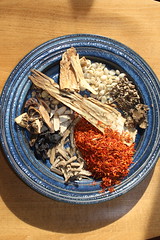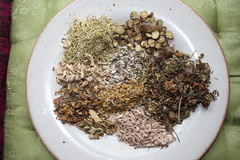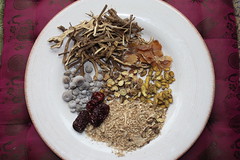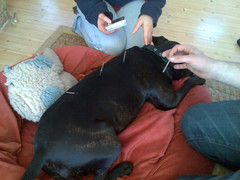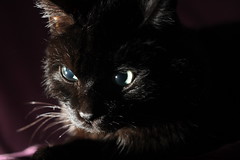Feline Stomatitis – how to stop the pain
Saturday, May 28th, 2011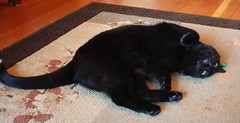 As I write this, my cat Raven is zipping around the living room playing and talking to himself. I know cats often do that, but Raven hasn’t been lately. This is made even more remarkable when you consider that he had a major surgery to remove all his molars and premolars and the connecting periodontal ligaments a little over a week ago. Raven feels good, better than he has felt in over a year. It warms my heart to see him happy again.
As I write this, my cat Raven is zipping around the living room playing and talking to himself. I know cats often do that, but Raven hasn’t been lately. This is made even more remarkable when you consider that he had a major surgery to remove all his molars and premolars and the connecting periodontal ligaments a little over a week ago. Raven feels good, better than he has felt in over a year. It warms my heart to see him happy again.
Feline stomatitis is the most painful disease in cats. Cats with stomatitis have severe inflammation in their mouths and sometimes back into their throats, far beyond normal dental disease. What makes it even worse is that because it effects the mouth, many cats with stomatitis don’t want to eat.
There are three main types of stomatitis.
- Juvenile stomatitis effects kittens and very young (less than a year and a half) cats. It is usually inflammation around the molars and premolars. This form of stomatitis can usually be cleared up by daily brushing and care of your cat’s teeth. It often times can be resolved by the time they are two years old with good care and never come back again.
- Rostral stomatitis effects mostly the front of the mouth and teeth. There is severe inflammation in this form of the disease, which seems to be more of a reaction to the bacteria and plaque on the teeth. This form of disease can be quite painful and lead to secondary infections as well. Rostral stomatitis can be completely cleared up if all the teeth are pulled. I have another cat, Melody, who had this form of disease. I had all her teeth pulled ten years ago when she was two and she has done great. She has no pain or inflammation. Rostral stomatitis can also be managed with very good dental care and antibiotics. This usually involves professional dental cleanings every six months, daily brushing and occasional antibiotics. In many of these cats it makes more sense to pull the teeth.
- Caudal stomatitis is the last type of this disease and the most severe. This is the form Raven has. It involves severe inflammation and ulceration around the molars, premolars and usually the oropharynx and throat behind the teeth. This form of stomatitis is chronic and usually impossible to completely resolve. With no treatment many cats will stop eating and die from the severe pain and inflammation.
Here is a link to an article with some great photos of stomatitis (warning – somewhat graphic)
Feline Stomatitis
So how do you treat caudal feline stomatitis?
I tried to treat this disease just holistically in Raven and while I feel like I bought some time I do believe that this disease needs to be treated with extraction. By the time I scheduled Raven to have his teeth pulled, he would often scream while eating if he was not on pain meds. He did better once I started making my own cat food for him but clearly he needed something that would permanently remove the pain. The best prognosis is in pulling the teeth early in the disease process.
- The best thing you can do is to see a veterinary dentist. These professionals really know what they are doing. The procedure being done by most of these dentists is to remove all the premolars and molars and the periodontal ligaments. I know it sounds like a big surgery but these poor cats are in so much pain and they immediately feel better. Raven went home the day of surgery on pain meds and was already playing again. It is very important to make sure that no roots are left when the teeth are pulled. If you go to a dentist they will make sure that no roots are left and remove the ligaments as well. This gives the best prognosis for a pain free life. Raven’s dentist, Dr. DuPont, gave a 80% chance that once Raven recovered he would be able to live a normal life with no medication even though he would still have some inflammation in the mouth. This can vary on the severity of disease, how long it has been going on and if steroids have been given or not.
- Get the teeth pulled as soon as possible. The sooner the teeth are removed, the better the prognosis. Really! They do so much better without the teeth.
- Avoid giving steroids. Many vets recommend steroid injections for this disease and the steroid will clear up the symptoms for awhile. However Dr. DuPont told me he has found that the prognosis gets worse for every steroid injection that is given. It may be that cats with more severe disease get more steroid injections so it is hard to put a direct cause and effect on this. The cats with the best prognosis have not had steroids. Raven had only had one steroid injection so his prognosis was still pretty good but it would have been even better without that one shot.
- Follow the protocol given by the dentist after the teeth are removed. This often is a few weeks of antibiotics. I know it is hard to get drugs down a cat but it is important to get proper healing and clear up any infection
- Get your cat on a grain free canned food diet. This helps to decrease the inflammation in their body and can help to reduce the inflammation in the mouth. I have Raven on a mix of mostly my homemade cat food – see Making Crazy Awesome Homemade Cat Food, and occasional Instinct canned cat food, and Rad Cat raw food. Avoid anything with bone bits as they can irritate the tissue in the mouth of these cats.
- Consider herbal treatments if there is still severe inflammation after the teeth are pulled. I was able to control the inflammation in Raven’s mouth successfully with Hoxsey like formula with Agrimony and Yellow Dock Root for about six months. This formula helps to pull blood away from inflammation, decreasing the inflammation, and heal mouth ulcerations. I hope I do not need to use it now that Raven’s teeth are gone but I am hopeful that if he has any flare ups I can get it under control with these herbs.
- Use pain medication if needed. The most common pain medication given is buprenorphine. Some vets use Metacam but usually given long term it will start to destroy the kidneys and is not a good choice for long term use.
Why does this disease occur?
We don’t know. It is more common in certain breeds of cats like the Siamese and Abbyssinians. It is more common in cats who had rough starts to life as kittens.
There may be viral factors involved but we don’t know for sure. Cats with FIV and FeLV have more problems with it. Cats with stomatitis are more likely to test positive to herpes and calici viruses then normal cats.
It does seem to have an autoimmune component. The immune system is overreacting to the plaque and bacteria or fighting against the teeth or ligaments holding the teeth themselves. Is there an allergy component to it? Maybe. I found Raven’s inflammation would flare up with any grain in his diet.
Someday we may have the answers and in finding them a better way to treat this disease. In the meantime, pulling the teeth is the best we have and well worth it for our cat companions’ comfort.
Update 11/16/13 – A reader recently asked me how Raven was doing and I realized it would be good to add an update. Raven is now five years old – it has been about 2 1/2 years since his teeth were pulled. His mouth looks great and he has shown no symptoms of any pain ever. He is a happy, energetic boy! We are lucky.














